2017 MERCEDES-BENZ S-CLASS CABRIOLET engine
[x] Cancel search: enginePage 353 of 521
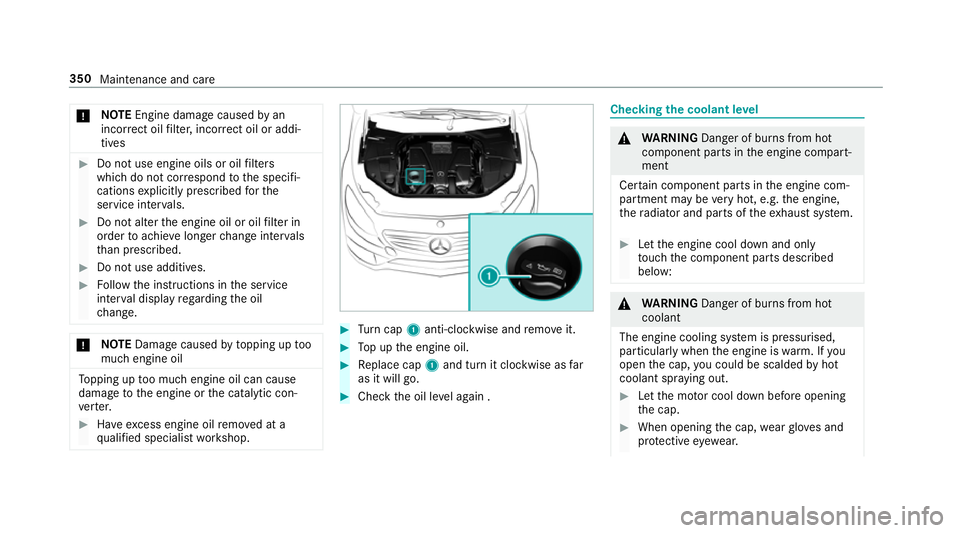
*
NO
TEEngine damag ecaused byan
incor rect oil filter ,incor rect oil or addi‐
tives #
Do no tuse engine oil soroilfilters
whic hdon otcor respond tothes pecifi‐
cation sexplicit lyprescribed fort he
service inter vals. #
Do no talter thee ngine oil or oil filter in
order toachie velonger chang einter vals
th an presc ribed. #
Do no tuse additives. #
Followt he instructions in thes ervice
inter vald ispla yregarding theo il
ch ange. *
NO
TEDama gecaused bytopping up too
muc hengine oil To
pping up toom uche ngine oil can cause
damag etothe engine or thec atalytic con‐
ve rter. #
Have excess engine oil remo vedata
qu alified specialis tworks hop. #
Turn cap 1anti-clockwise and remo veit. #
Topupt he engine oil. #
Replace cap 1and tur nitclockwise as far
as it will go. #
Chec kthe oil le vela ga in . Checking
thec oolant le vel &
WARNING Danger of bu rnsf romh ot
component parts in thee ngine compart‐
ment
Cer tain component parts in thee ngine com‐
partmen tmaybe very hot, e.g. thee ngine,
th er adiator and parts of thee xhau stsystem. #
Letthe engine cool down and only
to uc ht he component parts described
below: &
WARNING Danger of bu rnsf romh ot
coolant
The engine cooling sy stem is pressurised,
particularly when thee ngine is warm.Ify ou
open thec ap, youc ould be scalded byhot
coolant spr aying out. #
Letthe mo torc ool down befor eopening
th ec ap. #
When opening thec ap, wearglove sand
pr otectiv eeyewe ar. 350
Maintenanc eand care
Page 354 of 521
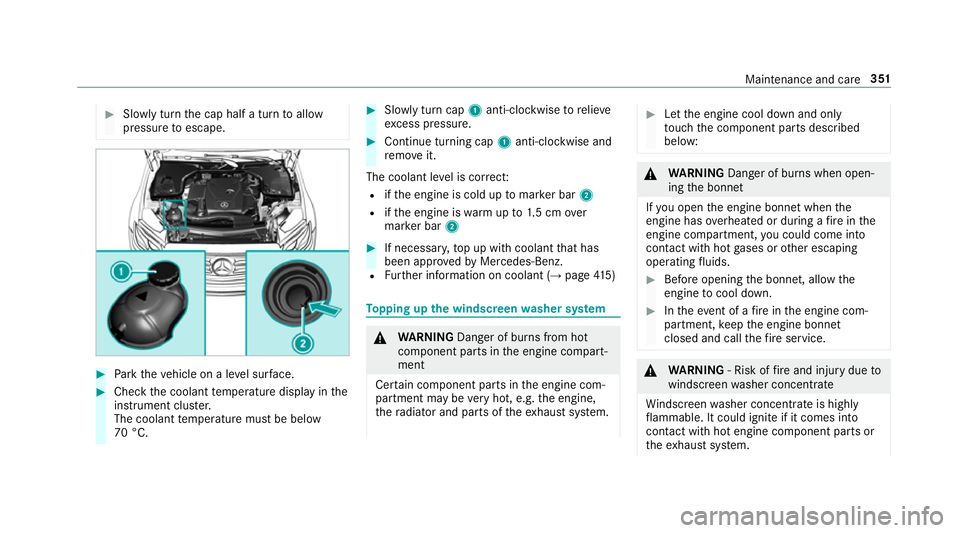
#
Slowly tur nthe cap half aturntoa llow
pressur etoescape. #
Park thev ehicle on alevel sur face. #
Chec kthe coolant temp eratur edispla yint he
instrument clus ter.
The coolant temp eratur emustbeb elow
70 °C. #
Slowl yturnc ap 1 anti-clockwise torelie ve
exc ess pressure. #
Continue turning cap 1anti-clockwise and
re mo veit.
The coolan tleve lisc orrect:
R ifth ee ngine is cold up tomar kerb ar2
R ifth ee ngine is warm upto1.5c mo ver
mar kerb ar2 #
If necessar y,topupw ithc oolant that has
been appr ovedbyM ercedes-Benz.
R Further information on coolant (→ page415 ) To
pping up the windsc reen washer sy stem &
WARNING Danger of bu rnsf romh ot
component parts in thee ngine compart‐
ment
Cer tain component parts in thee ngine com‐
partmen tmaybe very hot, e.g. thee ngine,
th er adiator and parts of thee xhau stsystem. #
Letthe engine cool down and only
to uc ht he component parts described
below: &
WARNING Danger of bu rnsw hen open‐
ing theb onnet
If yo uo pen thee ngine bonn etwhen the
engine has overheated or during afireint he
engine compartment, youc ould come into
contact wit hhotgases or other escaping
operating fluids. #
Befor eopening theb onnet ,allowt he
engine tocool down. #
Inthee vent of afireint he engine com‐
partment, keep thee ngine bonn et
closed and cal lthe fire service. &
WARNING ‑Riskoff irea nd injur ydue to
windscreen washer concentrate
Wi ndsc reen washer concentrat eishighly
fl ammable. It coul dignit eifitc omes into
con tact wi thhote ngine component parts or
th ee xhau stsystem. Maintenanc
eand care 351
Page 377 of 521

#
Avoid fire ,n aked flames ,creating
spar ksand smoking. #
Mak esuret hat ther eiss ufficient venti‐
latio ndurin gthe chargin gprocess and
during startin gassis tance. #
Do no tlea no verab atter y. If
th ei ndicator/warning lamps in thei nstrument
clus terdon otlight up at lo wtemperatures, it is
ve ry likel ythat thed ischar gedb atter yhas fro‐
zen. &
WARNING Risk ofexplosion from afro‐
zen battery
Ad ischar gedb atter ymayfreeze at temp era‐
tures slightl yabove or belo wfreezing point.
During startin gassis tance or batter ycharg‐
ing, batter ygas ma ybereleased. #
Alw ayst hawaf roze nb atte ry out first
befor echarging it or per form ing start‐
ing assis tance. The service li
feof ab atter ythat has been
th awe dmaybe dramaticall yshor tened. It is
recommended that youh ave athawe db at‐
te ry checkedataq ualified specialis tworks hop.
All vehicles
* NO
TEDama gecaused bynumerou sor
ex tende dattem ptstos tart thee ngine Nume
rous or extende dattem ptstos tart the
engine ma ydamag ethe catalytic con verter
due tonon-combu sted fuel. #
Avoid numerous and extende dattem pts
to star tt he engine. Obser
vethef ollowing points during starting
assis tance and when chargin gthe battery:
R Onlyuse undamaged jum plead/charging
cables wit hasufficient cross-section and
insula tedt erminal clamps.
R Non- insulated parts of thet erminal clamps
mus tnotcom eintoc ontac twitho ther me tal
parts while thej um plead/charging cable is
connected totheb attery/jump-s tart connec‐
tion point. R
The jum plead/c harging cable mus tnot
come int ocontact wi thanyp arts whic hmay
mo vewhen thee ngine is running.
R Alw aysm akes uret hat neither youn orthe
batter yiselectrost aticall ychar ged.
R Keep away from fire and naked flames.
R Do no tlean overthe batter y.
R When charging: only use batter ychargers
te sted and appr ovedbyM ercedes-Benz, and
please read theb atter ychar ger's operating
instructions befor echarging theb atter y.
Obser vethea dditional following point sduring
st artin gassis tance:
R Startin gassis tance ma yonly be pr ovided
using batteries wit hanominal voltag eof
12 V.
R The vehicles mus tnottouch.
R Petrol engine: only acceptstartin gassis‐
ta nce if thee ngine and exhaus tsystema re
cold. #
Secur ethe vehicle byapplying thee lectric
parking brake. 374
Breakdown assis tance
Page 378 of 521
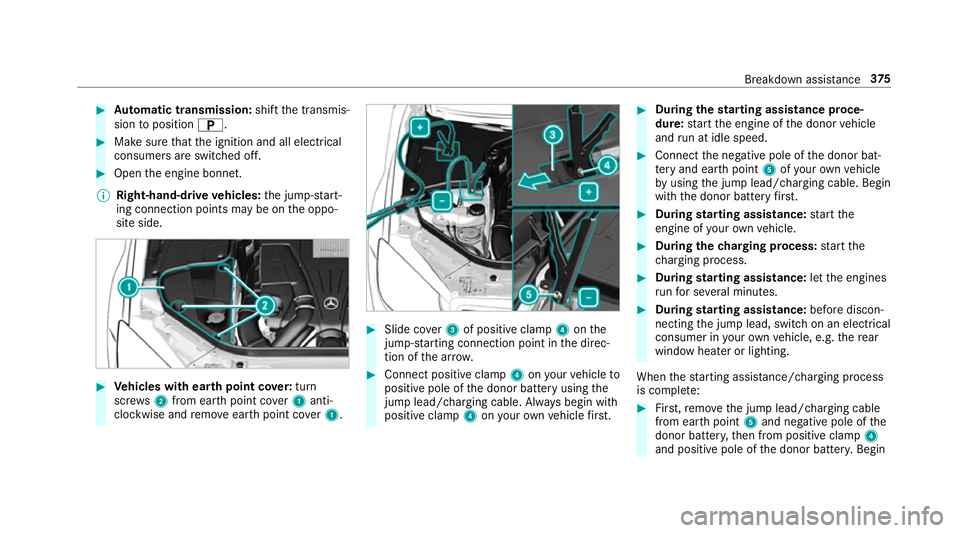
#
Automatic transmission: shiftthet ransmis‐
sion toposition B. #
Mak esuret hat thei gnition and all electrical
consumer sareswitched off. #
Open thee ngine bonn et.
% Right-hand-driv evehicles: thej ump-s tart‐
ing connection point smaybe on theo ppo‐
sit es ide. #
Vehicles with ear th point co ver:turn
sc rews 2 from ear thpoint co ver1anti-
clockwise and remo veear thpoint co ver1. #
Slide co ver3of positiv eclamp 4onthe
jump-s tarting connection point in thed irec‐
tion of thea rrow. #
Connect positiv eclamp 4onyour vehicle to
positiv epole of thed onor batter yusing the
jum plead/ charging cable .Alway sb egin with
positiv eclamp 4onyour ow nv ehicle firs t. #
During thes tarting assistance proce‐
du re: star tt he engine of thed onor vehicle
and runati dles peed. #
Connect then egativ epole of thed onor bat‐
te ry and ear thpoint 5ofyour ow nv ehicle
by usin gthe jum plead/charging cable. Begin
wit hthe donor batter yfirst. #
During starting assi stance: star tt he
engine of your ow nv ehicle. #
During thec hargin gproce ss: star tt he
ch argin gprocess. #
During starting assi stance: lett he engines
ru nf or se veralm inutes. #
During starting assi stance: beforediscon‐
necting thej um plead, switc honanelectrical
consumer in your ow nv ehicle, e.g. ther ear
windo wheater or lighting.
When thes tartin ga ssis tance/charging process
is compl ete: #
First,r emo vethej um plead/charging cable
from ear thpoint 5and negativ epole of the
donor batter y,then from positiv eclamp 4
and positiv epole of thed onor batter y.Begin Breakdown assis
tance 375
Page 383 of 521
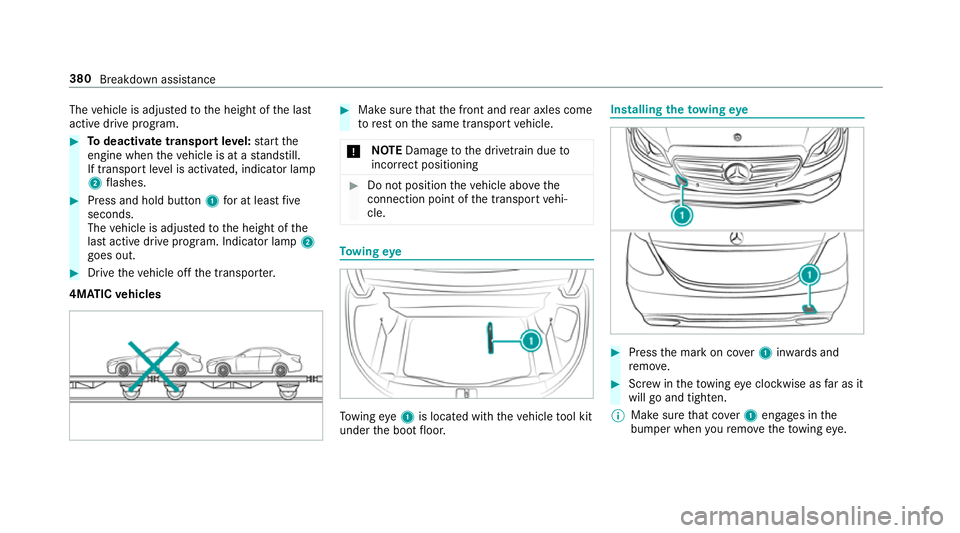
The
vehicle is adjus tedtot he height of thel ast
activ edrive prog ram. #
Todeactivat etranspo rtleve l:star tt he
engine when thev ehicle is at astandstill.
If transpo rtleve lisa ctivated, indicator lamp
2 flashes. #
Press and hold button 1foratl east five
seconds.
The vehicle is adjus tedtot he height of the
las tactiv edrive prog ram. Indicator lamp 2
goes out. #
Driv ethe vehicle of fthe transpor ter.
4MATIC vehicles #
Mak esuret hat thef ront and rear axle scome
to rest on thes ame transpor tvehicle.
* NO
TEDama getothed rive trai ndueto
incor rect positioning #
Do no tposition thev ehicle abo vethe
connection point of thet ranspor tvehi‐
cle. To
wing eye To
wing eye1is located wit hthe vehicle tool kit
under theb ootfloor. Installin
gthe towing eye #
Press them arkonc over 1 inwa rdsa nd
re mo ve. #
Screw inthet ow ing eye clockwise as farasit
willgoa nd tighten.
% Mak esuret hat co ver1engages in the
bumper when your emo vethet ow ing eye. 380
Breakdown assis tance
Page 384 of 521

*
NO
TEDama gedue toincor rect us eof
th et ow ing eye When
atow ing eyeisu sedtoreco verav ehi‐
cle, thev ehicle ma ybedamaged in thep roc‐
ess. #
Onlyusethet ow ing eyetot owaway or
to ws tartthe vehicle. To
w- starting thev ehicle (emer gency engine
st arting) Ve
hicles with automatic transmission
* NO
TEDama getothea utomatic trans‐
mission due to tow-starting The automatic transmissio
nmaybe damaged
in thep rocess of tow- startin gvehicles with
automatic transmission. #
Vehicles wit hautomatic transmission
mus tnotbe tow- star ted. #
Vehicles wit hautomatic transmission must
no tbet ow-sta rted. Electrical fuses
Note
sone lectrical fuses &
WARNING Risk of accident and inju ry
due to ov erloaded lines
If yo um anipulat eorbridg eaf aulty fuse or if
yo ur eplace it wit hafuse wit hahigher
amperage, thee lectric line could be overloa‐
ded.
This could result in afire. #
Alwa ys replace faulty fuse swiths peci‐
fi ed ne wfuses conta iningthe cor rect
amperage. *
NO
TEDama gecaused byincor rect fuses Incor
rect fuses ma ycause damag etoelectri‐
cal components or sy stems. #
Onlyuse Mercedes-Benz appr oved
fuse switht he cor rect fus erating. Bl
ow nfuses mustbe replaced wit hfuses of the
same rating ,which youc an recognise bythec ol‐
our and fuse rating .The fuse rating sarelist ed in th
ef use assignmen tdiagram. The fuse assign‐
ment diagram is in thev ehicle document wallet.
* NO
TEDama geor malfunctions caused
by moisture Moistur
emaycause dama getothee lectrical
sy stem or cause it tomalfunction. #
When thef use bo xisopen, mak esure
th at no moistur ecan enter thef use
box. #
When closing thef use box, mak esure
th at thes eal of thel id is positioned cor‐
re ctly on thef use box. If
th en ewlyinser tedf use also blo ws,have the
cause trace dand rectifie dataq ualified special‐
is tw orks hop, e.g. aMercedes-Benz Service
Centre.
Ensur ethe following befor ereplacing afuse:
R The vehicle is secured agains trolling away.
R All electrica lconsumer sareswitched off.
R The ignition is switched off. Breakdown assi
stance 381
Page 385 of 521
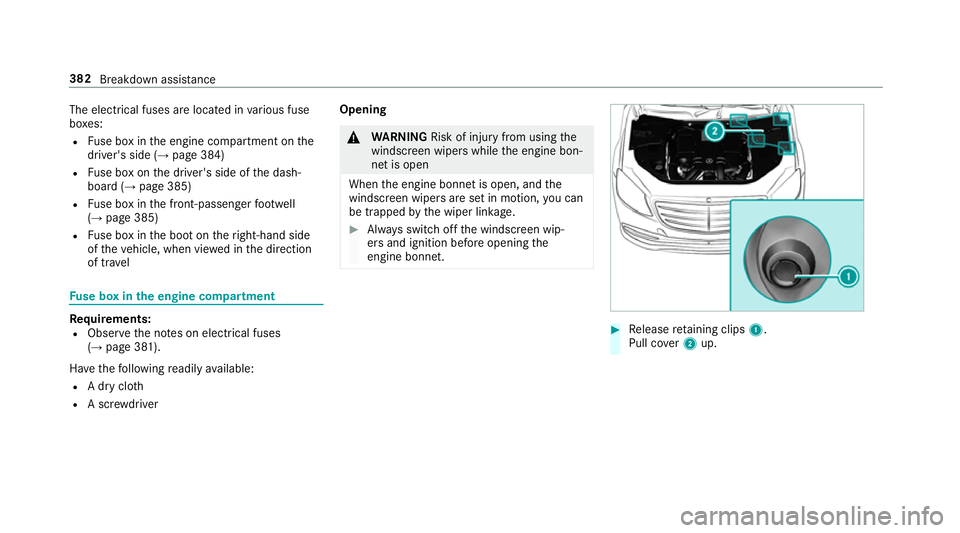
The electrical fuses ar
elocated in various fuse
bo xes:
R Fuse bo xinthe engine compartment on the
driver's side (→ page384)
R Fuse bo xont he driver's side of thed ash‐
boar d(→pag e385)
R Fuse bo xinthe front-passenge rfootwell
(→ pag e385)
R Fuse bo xinthe boo tontheright-hand side
of thev ehicle, when vie wedint he direction
of tra vel Fu
se bo xinthe engine compartment Requ
irements:
R Obser vethen otes on electrical fuses
(→ pag e381).
Ha ve thef ollowing readil yavailable:
R Adryclo th
R Ascrew driver Opening &
WARNING Risk of inju ryfrom using the
windscreen wiper swhile thee ngine bon‐
ne tiso pen
When thee ngine bonn etis open ,and the
windscreen wiper saresetinm otion, youc an
be trapped bythew iper linkage. #
Alw ayss witc hoffthew indscreen wip‐
er sa nd ignition befor eopening the
engine bonn et. #
Release retainin gclips 1.
Pull co ver2up. 382
Breakdown assi stance
Page 401 of 521
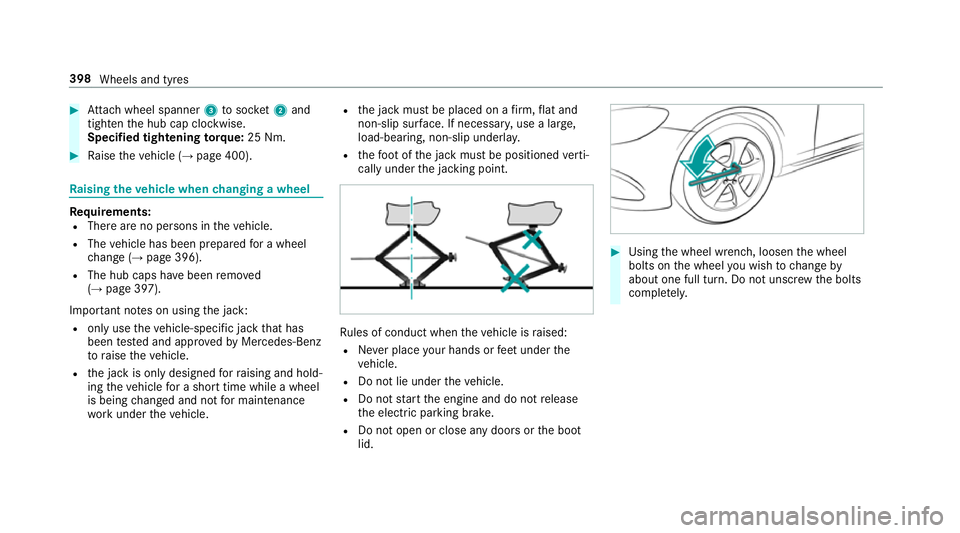
#
Attach wheel spanner 3tosoc ket 2and
tighten theh ub cap clockwise.
Specified tightening torq ue: 25 Nm. #
Raise thev ehicle (→ page400). Ra
ising thev ehicle when changing awheel Re
quirements:
R Ther eareno persons in thev ehicle.
R The vehicle has been prepared foraw heel
ch ang e(→pag e396).
R The hub caps ha vebeen remo ved
( → pag e397).
Impor tant no tesonu singthej ack:
R onlyusethev ehicle-specific jac kthat has
been tested and appr ovedbyM ercedes-Benz
to raise thev ehicle.
R thej ackiso nlyd esigned forr aising and hold‐
ing thev ehicle foras horttime while awheel
is being changed and no tfor maintenance
wo rkunder thev ehicle. R
thej ackm ustbep laced on afirm, flat and
non-slip sur face. If necessar y,use alarge,
load-bearing, non-slip underla y.
R thef ootoft he jac kmustbep ositioned verti‐
call yunder thej acking point. Ru
les of conduct when thev ehicle is raised:
R Neverp lace your hands or feet under the
ve hicle.
R Do no tlie under thev ehicle.
R Do no tstar tthe engine and do no trelease
th ee lectric parking brake.
R Do no topen or close an ydoor sort he boot
lid. #
Using thew heel wrench, loosen thew heel
bolts on thew heel youw ish tochang eby
about on efull turn. Do no tunscr ewtheb olts
comple tely. 398
Wheels and tyres